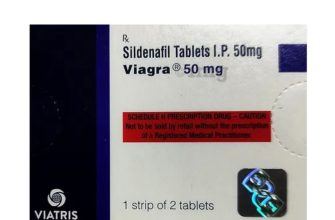Taking Viagra, or sildenafil, might affect your vision. Some users report experiencing temporary changes in color vision, such as seeing a bluish tinge. This usually resolves itself quickly after the medication wears off. However, more serious side effects, though rare, are possible.
Specifically, non-arteritic anterior ischemic optic neuropathy (NAION) has been linked to Viagra use. NAION is a condition that can cause sudden vision loss. If you experience sudden vision changes after taking Viagra, seek immediate medical attention. This is crucial for timely diagnosis and treatment.
Pre-existing eye conditions increase the risk of experiencing NAION. Individuals with high blood pressure, diabetes, high cholesterol, or a history of heart disease are particularly vulnerable. Open communication with your doctor about your complete medical history, including any eye problems and medications you’re taking, is paramount before starting Viagra or similar drugs.
Remember: This information is for general knowledge and doesn’t substitute professional medical advice. Always consult your ophthalmologist or physician before starting any new medication, especially if you have pre-existing eye conditions. They can assess your individual risk and guide you on the safest course of action. Your eye health is your responsibility.
- Viagra and Eye Disease: A Detailed Look
- Viagra’s Mechanism of Action and its Impact on Blood Vessels
- Impact on Systemic Blood Vessels
- Potential Eye-Related Implications
- NAION (Non-arteritic Anterior Ischemic Optic Neuropathy) and Viagra: The Link Explained
- Risk Factors for NAION
- Viagra and NAION: The Connection
- What to Do
- Disclaimer
- Risk Factors for NAION Exacerbated by Viagra Use
- Symptoms of NAION to Watch Out For After Viagra Consumption
- Key Vision Changes to Note:
- Other Possible Symptoms:
- Viagra and Other Eye Conditions: Potential Interactions
Viagra and Eye Disease: A Detailed Look
Consult your ophthalmologist before using Viagra, especially if you have pre-existing eye conditions. Viagra, or sildenafil, can affect blood vessels, potentially impacting blood flow to the eyes.
Non-arteritic anterior ischemic optic neuropathy (NAION) is a rare but serious side effect linked to Viagra. This condition causes sudden vision loss. Men with pre-existing risk factors for NAION, such as high blood pressure or diabetes, face a heightened risk. Regular eye exams are crucial for early detection.
Other potential eye problems associated with Viagra include changes in color vision, increased sensitivity to light, and blurry vision. These side effects are generally temporary and mild, resolving upon cessation of Viagra use. However, persistent or worsening symptoms warrant immediate medical attention.
Specific recommendations: Individuals with a history of NAION or other optic nerve disorders should avoid Viagra. Those with diabetes, hypertension, or heart disease should discuss the risks with their doctor before using the medication. Open communication with your healthcare provider ensures safe and informed decision-making regarding Viagra use.
This information is for educational purposes only and does not substitute professional medical advice. Always seek personalized guidance from your doctor or ophthalmologist regarding your specific health circumstances.
Viagra’s Mechanism of Action and its Impact on Blood Vessels
Viagra, or sildenafil, primarily works by inhibiting phosphodiesterase-5 (PDE5). This enzyme usually breaks down cyclic guanosine monophosphate (cGMP), a molecule crucial for relaxing smooth muscles in blood vessel walls. By blocking PDE5, Viagra increases cGMP levels. Higher cGMP levels lead to vasodilation – widening of blood vessels. This enhanced blood flow is particularly noticeable in the penis, facilitating erections.
Impact on Systemic Blood Vessels
While Viagra’s effect on penile blood vessels is its primary therapeutic target, it also affects other blood vessels throughout the body. This systemic vasodilation can lower blood pressure, which is why it’s contraindicated in individuals with certain cardiovascular conditions. The magnitude of this effect varies depending on factors such as dosage and individual physiological responses. Patients with pre-existing conditions like hypertension or heart problems should consult their doctors before using Viagra.
Potential Eye-Related Implications
The vasodilatory effect of Viagra can influence blood vessels in the eye. Increased blood flow to the optic nerve and retina may benefit some conditions, but in others, this increased pressure could exacerbate pre-existing issues. Further research is needed to fully understand the complex interplay between Viagra, blood vessel function, and ocular health.
NAION (Non-arteritic Anterior Ischemic Optic Neuropathy) and Viagra: The Link Explained
Viagra, containing sildenafil, increases blood flow throughout the body. This increased blood flow can, in rare cases, affect the optic nerve, potentially leading to NAION, a condition causing sudden vision loss. Men with pre-existing risk factors for NAION are more susceptible to this complication.
Risk Factors for NAION
Several factors increase the likelihood of developing NAION, including high blood pressure, diabetes, high cholesterol, and a history of cardiovascular disease. Age is also a significant factor; NAION is more common in men over 50. Anatomical variations in the optic nerve’s blood supply also contribute to increased risk.
Viagra and NAION: The Connection
The increased blood pressure and altered blood flow caused by Viagra may compromise the already vulnerable blood supply to the optic nerve in individuals with these risk factors. This can trigger ischemia (reduced blood flow) leading to NAION. It’s crucial to understand that this is not a common side effect, but the risk is undeniably present for some.
What to Do
If you have any of the risk factors listed above and are considering Viagra, discuss the potential risk of NAION with your doctor. A thorough eye exam may be recommended before starting Viagra treatment. Open communication with your healthcare provider is paramount to ensuring your safety.
Disclaimer
This information is for educational purposes only and does not constitute medical advice. Always consult your physician before starting any new medication.
Risk Factors for NAION Exacerbated by Viagra Use
Men taking Viagra face a heightened risk of Non-arteritic Anterior Ischemic Optic Neuropathy (NAION), a serious eye condition causing vision loss. Understanding these risk factors is crucial for informed decision-making.
Several factors significantly increase the likelihood of NAION onset or exacerbation when using Viagra:
- Pre-existing cardiovascular disease: Conditions like high blood pressure, high cholesterol, and coronary artery disease substantially raise NAION risk. Careful monitoring and discussion with your doctor are vital.
- Age: Men over 50 are more susceptible. The aging process affects blood vessel health, making them more vulnerable.
- Diabetes: This condition damages blood vessels, increasing the chance of NAION. Strict blood sugar control is recommended.
- Smoking: Nicotine constricts blood vessels, further compromising blood flow to the optic nerve. Quitting is strongly advised.
- High blood pressure (hypertension): Uncontrolled hypertension stresses blood vessels, making them prone to blockage.
- High cholesterol (hyperlipidemia): High cholesterol contributes to plaque buildup in arteries, potentially affecting blood supply to the optic nerve.
- Glaucoma: Individuals with glaucoma already have compromised blood flow to the optic nerve, making them more vulnerable to NAION.
- Sleep apnea: This condition causes intermittent drops in blood oxygen levels, stressing the circulatory system. Treatment is recommended.
- Prior NAION episode: Having experienced NAION before significantly increases the risk of recurrence, especially with Viagra use.
Consult your physician before using Viagra, especially if you have any of these conditions. Open communication about your health history and medications is key to minimizing risk.
This information serves as a guide and should not replace professional medical advice. Always consult a doctor for personalized guidance.
Symptoms of NAION to Watch Out For After Viagra Consumption
If you experience sudden vision loss, even partially, after taking Viagra, seek immediate medical attention. This could be a sign of Non-Arteritic Anterior Ischemic Optic Neuropathy (NAION), a serious eye condition. Don’t delay; prompt treatment is critical.
Key Vision Changes to Note:
Pay close attention to these specific vision problems: blurry vision, particularly in one eye; loss of color vision; a dark or shadowed area in your visual field; or pain in or around your eye. These symptoms often develop suddenly. Don’t dismiss these as minor issues; they warrant immediate evaluation.
Other Possible Symptoms:
Beyond vision changes, NAION can sometimes present with headache or eye pain. While these aren’t always present, their presence alongside vision problems makes NAION more likely. Report any such symptoms alongside vision problems.
Remember, prompt medical attention is key to managing NAION. Early intervention significantly improves the chances of successful treatment and better vision outcomes.
Viagra and Other Eye Conditions: Potential Interactions
Consult your ophthalmologist before using Viagra if you have any pre-existing eye conditions. Viagra, like other phosphodiesterase-5 (PDE5) inhibitors, can affect blood vessels, potentially impacting those in the eyes.
Dry eye syndrome: Viagra’s effect on blood flow might exacerbate symptoms. Monitor for increased dryness and discuss any changes with your doctor.
Glaucoma: While not directly contraindicated, Viagra’s impact on blood pressure requires careful monitoring, especially for those with glaucoma, as increased pressure can worsen the condition. Regular eye pressure checks are recommended.
Macular degeneration: There’s limited research on direct interaction. However, because Viagra affects blood flow, individuals with macular degeneration should discuss its use with their ophthalmologist to assess potential risks.
Retinitis pigmentosa: Patients with this rare, inherited eye disease should exercise extreme caution. PDE5 inhibitors have been associated with potential visual disturbances in some cases. A thorough discussion with an eye specialist is absolutely necessary.
Note: This information is for general knowledge and doesn’t replace professional medical advice. Always discuss potential drug interactions with your doctor or ophthalmologist before starting any new medication.










